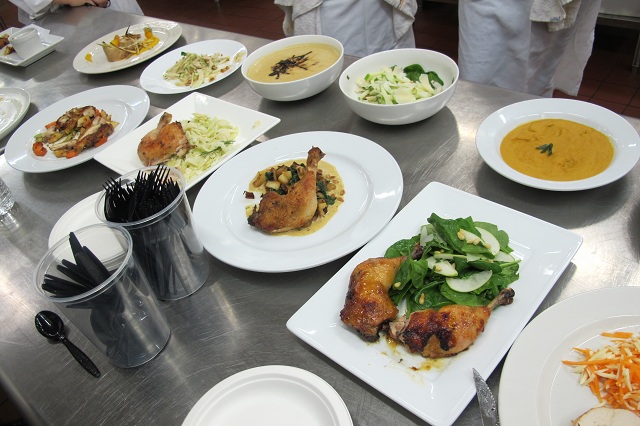Cooking Up a Storm: The Student Experience in the Culinary Arts Lab
by Korakot ‘Gab’ Suriya-arporn

“Five minutes! Food must be up front!” yells the male chef. A collective “Yes, Chef!” quickly follows, and students dressed in their chef’s whites hurry to bring heated dishes to the plating space, quickly sauté Brussels sprouts with crispy bacon, ladle the butternut squash soup into bowls, toss the mesclun greens with mustard vinaigrette, and reheat the perfectly seared rib-eye steak. With swift, decidedly meaningful, and efficient movements, plates are soon presented at the pass station. In contrast to the previous adrenalin rush, this is a moment of happiness, peace, and calm. All the food comes out beautifully and on time. This is another course nicely done.
As part of the Certificate Program in the Culinary Arts, the fascination of kitchen work is fully explored in the 14-week Culinary Arts Laboratory course. Students of various backgrounds come into the kitchen four days a week to learn about cooking techniques and gastronomic quirks— a great combination of lecture and hands-on learning. Daily lessons start with the foundations of preparing and cooking food, such as making stocks and butchering meat to different types of cooking methods and presentation.

All sensory tools are put to great use as we learn to watch, smell, hear, taste, and touch ingredients and dishes from a wide range of cuisines and cultures. Sensory knowledge is the most fundamental and perhaps crucial approach to food, as we feel the doneness of the grilled beef with our fingers, listen as the celery seeds pop in the heated pan, smell the fragrance of freshly chopped basil leaves, watch the sugar as it turns into amber-colored caramel, and taste the delicate texture of chocolate ganache and the crunchiness of hazelnut dacquoise. In addition, we learn to not only create delicious and aesthetically pleasing food, but a whole new perspective to see food that also promotes sustainability and self-sufficiency in the food system.
As part of the course, we learned from a number of renowned chefs from restaurants throughout the Boston area and beyond. Some — like Chef Jeremy Sewall from Island Creek Oyster Bar and Chef Chris Douglass from Ashmont Grill and Tavoloof — even arrange for students to visit their restaurants and learn to work in a professional kitchen. The connections made by meeting and getting to know these chefs are invaluable for those who want to submerge themselves in the Boston foodscape.

The course calendar is also marked with special events in which students participate. The biggest events last semester — the Julia Child Centenary events — united more than twenty chefs to celebrate the 100th birthday of The French Chef host and Gastronomy program co-founder. Students worked with these chefs, brushing shoulders as we helped to cook, prepare, and plate dishes, as if we are a part of their kitchen brigade. Of course, the biggest name chef would absolutely be Jacques Pepin.
As the program came to an end, we students set the menu and invited our friends and families to our graduation, which celebrates our learning, teamwork, and camaraderie. While we now each embark on our own food path, we have learned together, gaining more skills and confidence in cooking and baking and tackling the oft dreaded heat in the kitchen. We have learned some of the many ways to approach food and ingredients with deep respect, appreciation, and comprehension. The Culinary Arts Laboratory has truly changed our lives forever.
Korakot Suriya-arporn or “Gab” is a current Gastronomy student. He comes from Bangkok, Thailand, and has a background in journalism.